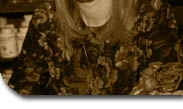(32)
This procedure was
repeated for all cages proceeding from
left to right.
It is important to
note that none of the food jars were identified
in any
manner, as to animal
number or dose level. The position of
the jar on the
cart was the only
means of identifying the proper dose level.
This procedure was
used when concentrations were changed.
At other times,
the feeder jars were
weighed; filled with the appropriate diet/dose,
weighed and replaced
in the cage. If a feed container was almost
empty,
or contained feces,
it would be replaced with a new container.
IDENTIFICATION OF
ANIMALS
No ear clips or other
methods of uniquely identifying each animal
were
used. Animals were
individually housed (one animal per cage)
and a color
coded card containing
the cage number, compound number, project
number
(Path-Tox No.), and
dose level was attached to each cage.
When an animal
died during the study,
the color coded identification card was
removed
from the cage and
accompanied the animal to the necropsy
laboratory.
Also attached to
each cage was a Mylar Card which identified
the an imals
for the Computer
System.
At the time of death
or sacrifice the animals were assigned
a pathology
number which was
used to identify the animal during tissue
processing, and
on all records pertaining
to pathology. The pathology number was
a
five-digit sequential
number assigned by the pathology department.
An
example of a pathology
number is 94.893. The number was etched
on all
slides as a permanent
identification.
All animals that
died during the study were assigned an
additional number
called a "Master
Number". The master numbers denote
the chronological
order in which the
animals died during the study, by dose
group. For
example, CM38 would
be the 38th Control Male to die during
the study.
Master numbers were
noted only on the gross pathology sheets
and not
recorded for all
animals. Four animals that died during
the study had no
master numbers. We
were not able to locate any other records
providing
the missing numbers.
Also, two of the master numbers (CM28
and CM29) were
out of sequence.
(33)
A chart was made
by the FDA team, which shows the animal
number (cage #),
pathology number,
master number, and the complete pathology
history of
each animal. The
chart is organized by dose group, and
is attached as
Exhibit #35.
ANTE-MORTEM OBSERVATIONS
"Observations
for Drug Effects" records are attached
as exhibits #70 & 71.
These records were
completed on a weekly basis for the first
four weeks,
every two weeks through
week 12, and every 4 weeks thereafter.
each
record lists the
animals in a specific housing group, and
entries are made
for the following
parameters: appearance and awareness,
rales, eyes, motor
activity sensory
loss, urine/feces, appetite/thirst, and
tissue
masses/lesions. There
is also a space for notes, and masses
are routinely
described on the
reverse side of the sheet. The top of
the sheet has
blocks for entering
the date of observations, number of weeks
on
treatment, and signature
or initials of the person making the
observations. It
was noted that many of the observation
records were not
signed or initiated.
Following is a tabulation of the numbers
of records
in which the person
making the observations is not identified.
HOUSING
GROUP NO. OF RECORDS
NOT SIGNED OR INITIALED
A 6 (wks 80, 92,
84, 88, 93, 94)
B 6 (wks 80, 84,
88, 92, 93, 96)
C 5 (wks 80, 84,
88, 92, 96)
D 7 (wks 79, 80,
84, 88, 92, 94, 96)
E 6 (wks 76, 80,
84, 88, 92, 96)
F 9 (wks 76, 77,
80, 81, 84, 88, 92, 93, 96)
G 5 (wks 80, 84,
88, 92, 96)
H 11 (wks 1, 68,
76, 80, 81, 83, 84, 88, 92,
95, 96)
J 6 (wks 76, 80,
84, 88, 92, 96)
K 8 (wks 71, 76,
80, 84, 88, 92, 93, 96)
L 5 (wks 76, 80,
84, 92, 96)
M 5 (wks 76, 80,
84, 92, 96)
TOTAL 79 records
not signed or initialed
In addition to the
lack of signatures, it was noted that
many of the
records were not
originals, but appeared to be xerox copies
of the
originals. Surprisingly,
some of the xerox copies had "original"
(34)
initials. It was
obvious that the initials had been placed
on these
sheets sometime after
the sheets had been filled out, and after
they had
been copied.
Some examples of
discrepancies of this type are as follows:
1.) In housing group
A, 26 of the 39 observation records were
xerox
copies with original
initials.
2.) In housing group
B, 27 of the 43 observation records were
xerox
copies with original
initials.
3.) The record for
week 76 of housing group A was a xerox
copy but the
date, initials, an
week are all original.
4.) For week 96 of
housing group K, both an original and
xerox copy of
the observation record
are present. The xerox copy has original
initials and a "B"
entered in the "tissue masses and
lesions"
column. There is
also an entry in the "notes"
column for rat
#K25CF. The original
record also has a "B" entered
in the
"notes"
column. All of the above entries had obviously
been
made sometime after
their original record had been completed
and
the xerox copy made.
5.) A record dated
4-27-73 for housing group M does not have
the date
entered. The observations
were made for this animal on sheets
covering weeks 92,
96, 100 and 104, indicating that the animal
was dead. The record
for week 108, however, shows that the
animal is alive,
with motor activity, appetite, and thirst.
The
record for week 112
again shows that the animal is dead.
In addition to the
discrepancy noted above, there is also
an obvious error
in the dating of
these records; the observation sheet for
week 92 is dated
June 13, l973, and
the observation sheet for week 88 is dated
July 16,
l973.
Ante-mortem observations
were also made on other types of records.
A
volume entitled "Tissue
Masses and Deaths" (exhibit #65)
has a record of
the date that each
animal died during the study. The deaths
are recorded
in two different
ways in this volume. One record has a
chronological list
of deaths, and another
record has a list of deaths organized
by housing
(35)
group. This volume
also has a "palpation Record",
which describes each
tissue mass, and
lists the date that it was initially detected.
It was noted that
many of the animals in the sequential
record of deaths
were listed out of
sequence. Following is a tabulation of
the animals
that were out of
sequence.
(* indicates animal
is listed out of sequence)
ANIMAL NO. DATE FOUND
DEAD NO. OF DAYS ON TREATMENT
E6HN 8-12-73 640
E24HM 8-16-73 640
G10LM *8-14-73 638
L11CM 5-6-73 535
C17CM *5-4-73 542
A14MM 5-21-73 560
A24HM 10-15-73 707
C14HM *10-27-73 718
E22CM 10-19-73 707
E29LM 10-25-73 714
A4CM 10-26-73 718
E26CM 11-15-73 735
C12LM *11-14-73 736
L20CM 11-19-73 732
AllCM 11-25-73 748
A18CM *11-18-73 741
J19MM 12-10-73 754
F25HF 6-10-73 576
D21CF *6-9-73 577
H6CF 6-17-73 579
M12CF *6-16-73 575
F18CF 7-22-73 615
H22LF *8-20-73 641
D25MF 7-25-73 623
G2LM 10-5-73 689
G7CM *6-14-73 567


